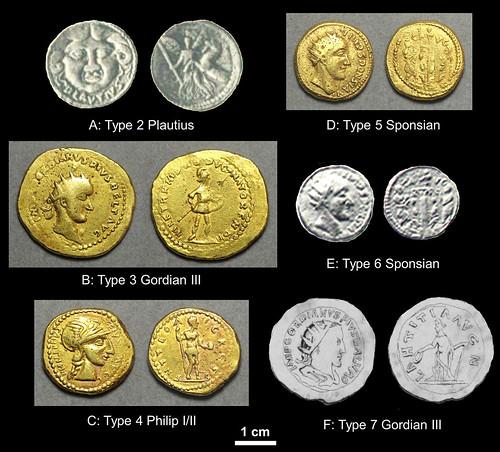
PREV ARTICLE
NEXT ARTICLE
FULL ISSUE
PREV FULL ISSUE
V25 2022 INDEX E-SYLUM ARCHIVE IS SPONSIAN REAL?An American Numismatic Society Pocket Change blog article by Alice Sharpless pushes back on last week's announcement from the Hunterian Museum. Here's an excerpt- see the complete article online. -Editor A new study, published by Paul N. Pearson et al. last week in Plos One, has made a sensation in global news by claiming to have authenticated several unusual gold coins in the Hunterian Museum collection in Glasgow which seem to feature an otherwise unknown Roman emperor Sponsianus. The coins, which numismatists have long believed to be early 18th-century forgeries, include two gold coins naming the Roman emperor Philip I or II, another naming Gordian III, and a fourth naming a Sponsianus, who is known only from a few examples of this coin type. All of these coins are ostensibly the exceedingly rare double aureus, though the weights are much higher than was typical. These coins are of uncertain origin but seem to have been part of a hoard discovered in 1713 in Transylvania. This hoard was recorded in a note by Carl Gustav Heraeus as including the same three coin types in Glasgow as well as three other types.
Since the publication of the Plos One study, there have since been several responses to the study. Aleksander Bursche and Kyrylo Myzgin have released a response pointing out several important problems that were not sufficiently addressed by the Plos One study. Alfred Deahl responded in a post from Antigone Journal, reasserting the belief that the coins are forgeries and Csaba Szabó has discussed methodological problems with the study. Björn Schöpe writing for CoinsWeekly cites additional critiques of the Plos One study. Scholars such as Johannes Wienand and Marjanko Pilekic have also taken to Twitter to discuss what it even means to say these are Clearly, there are still many unaddressed issues surrounding the origin of the 1713 coins. Even the evidence of wear and of surface deposits cannot be shown conclusively not to have occurred in the modern period. As Bursche and Myzgin point out, the coins should have been tested against third-century coins with secure find spots as well as known 18th-century forgeries rather than against third-century coins of uncertain provenience. Pearson et al. put far too much weight on these coins to write an imagined history of Dacia in the later third century with too little critical analysis of the problems with the coins' manufacture and discovery. Unless further study can provide more certain answers, it seems that these coins should continue to be regarded as modern forgeries.
To read the complete article, see:
Wayne Homren, Editor The Numismatic Bibliomania Society is a non-profit organization promoting numismatic literature. See our web site at coinbooks.org. To submit items for publication in The E-Sylum, write to the Editor at this address: whomren@gmail.com To subscribe go to: https://my.binhost.com/lists/listinfo/esylum All Rights Reserved. NBS Home Page Contact the NBS webmaster 
|

